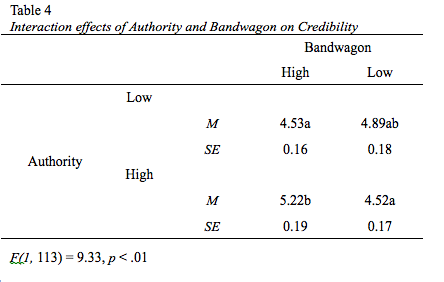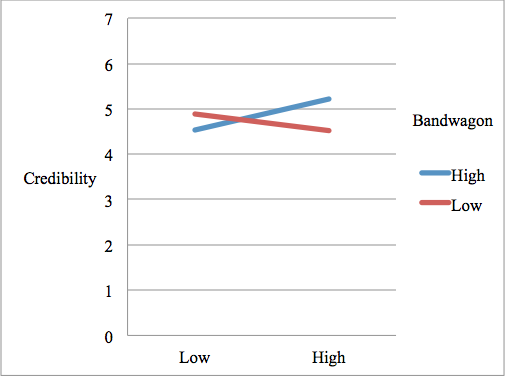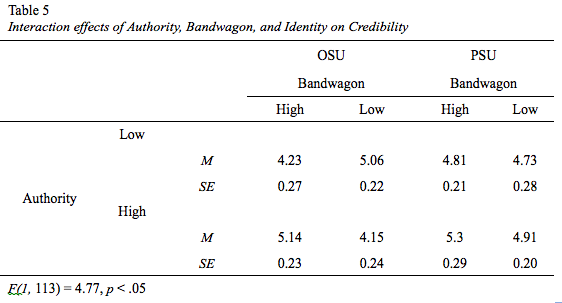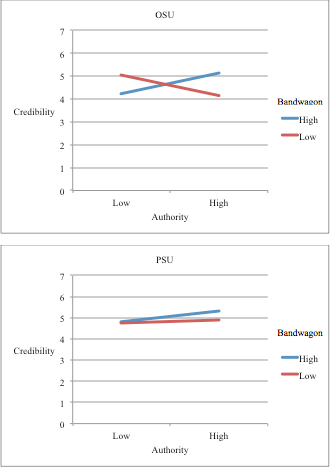Media Effects Research Lab - Research Archive
The effects of source cues in online news on credibility perception
Student Researcher(s)
Eun Go (Ph.D Candidate);
Eunhwa Jung (Ph.D Candidate);
Mu Wu (Ph.D Candidate);
Faculty Supervisor
NTRODUCTION
The Internet has provided tremendous amounts of information, which has been traditionally delivered by offline media, available to people quickly and easily (Liszka, Steyer, & Hueston, 2006). On the other hand, previous research has found that different interface cues influence users’ perception towards the online news contents. Among various interface cues, bandwagon and authority cues have been consistently found to have significant effects on media users’ perception on online content. However, in considering the effect of social distance on content perception, it is important to examine the effect of identity as a source characteristic, which differentiates the degree of social distance, on online news content evaluation. To examine the effects of these three types of heuristic cues in the online news consumption context, the current study conducted a 2 (authority cue: low vs. high) x 2 (bandwagon cue: low vs. high) x 2 (identity cue: in-group vs. out-group) online experiment.
RESEARCH QUESTION / HYPOTHESES:
H1: Higher level of bandwagon cue would generate more positive evaluation on the news story in terms of perceived a) credibility, b) liking, c) quality, and d) representativeness.
H2: Higher level of authority cue would generate more positive evaluation on the news story in terms of perceived a) credibility, b) liking, c) quality and d) representativeness.
H3: In-group identity cue would generate more positive evaluation of the news story in terms of perceived a) credibility, b) liking, c) quality, and d) representativeness.
H4: The combination of high authority cue and high bandwagon cue will lead to higher perceived a) credibility, b) liking, c) quality, and d) representativeness perception than other combinations.
RQ1: Are there interaction effects among identity, bandwagon, and authority cues on perceived a) credibility, b) liking, c) quality, and d) representativeness?
METHOD
The current study was a 2 (authority cue: low vs. high) x 2 (bandwagon cue: low vs. high) x 2 (identity cue: in-group vs. out-group) online between-subject experiment. All participants (N = 120) were randomly assigned to one of the eight conditions. For high-authority condition, we showed a simulated “Chicago Tribune” webpage with the news story, whereas for low-authority condition, we showed a simulated webpage of “National Enquirer” with the news story. Bandwagon cue was manipulated by changing the number of recommenders of the news article. Identity was manipulated by differentiating university affiliations of the recommenders. Participants in in-group condition were told that the recommenders are students from Penn State University, while participants in out-group condition were told that the recommenders are students from Ohio State University. Perceived credibility, liking, quality, and representativeness were measured as dependent variables.
RESULTS
To test hypothesis 1, one-way ANOVAs were conducted to examine the effect of bandwagon cue on perceived credibility, liking, quality, and representativeness. However, there were no significant effects of bandwagon cue on perceived credibility, F (1, 113) = .93, p = .33, perceived liking, F (1, 113) = .72, p = .40, perceived quality, F (1, 113) = .24, p = .62, and perceived representative, F (1, 113) = .001, p = .97. Therefore, hypothesis 1 was not supported.
To test hypothesis 2, The result of one-way ANOVA test showed that there was a marginally significant main effect for authority cue on perceived quality, F (1, 113) = 3.93, p = .05. However, no significant effects of authority cue on perceived credibility, F (1, 113) = .84, p = .36, perceived liking, F (1, 113) = .01, p = .91, and perceived representative, F (1, 113) = 1.54, p = .22 were found. Therefore, hypothesis 2 was partially supported.

To test Hypothesis 3, . The results revealed that there are no significant main effect for identity cue on all four sets of measures for online news content perception: perceived credibility, F (1, 113) = 2.87, p = .09, perceived liking, F (1, 113) = .11, p = .74, perceived quality, F (1, 113) = .36, p = .54, and perceived representative, F (1, 113) = 2.22, p = .14. Therefore, hypothesis 3 was not supported.
Two-way ANOVA was conducted to test hypothesis 4 that predicts the interaction effect between bandwagon and authority cues on online news content perceptions. A significant interaction effect of bandwagon and authority cues on perceived credibility, F (1, 113) = 9.33, p < .01 was found.


To answer the Research Question 1, we examined the interaction effect among bandwagon, authority, and identity cues through conducting a three-way ANOVA. The result indicated a significant three-way interaction effect of these three cues on perceived credibility, F (1, 113) = 4.77, p < .05


DISCUSSION/ CONCLUSION
The current study revealed that authority cue (e.g., news agency in this study) has a significant direct effect on users’ evaluation of online news in terms of news quality. A significant two-way interaction effects between bandwagon and authority cues on perceived credibility suggested a positive combinationary effect of these two types of cues. Moreover, the significant three-way interaction among these three types of cues indicated that the interaction effects between bandwagon and authority cues on news credibility evaluation tend to work as a function of identity cue. While confirming the importance of identity cue in online news judgment, three-way interaction effects confirmed the co-occurrence of heuristic and systematic processing, and suggested that people process news systematically when the recommenders are out-group members, whereas they process news heuristically when the recommenders are in-group members.
For more details regarding the study contact
Dr. S. Shyam Sundar by e-mail at sss12@psu.edu or by telephone at (814) 865-2173

